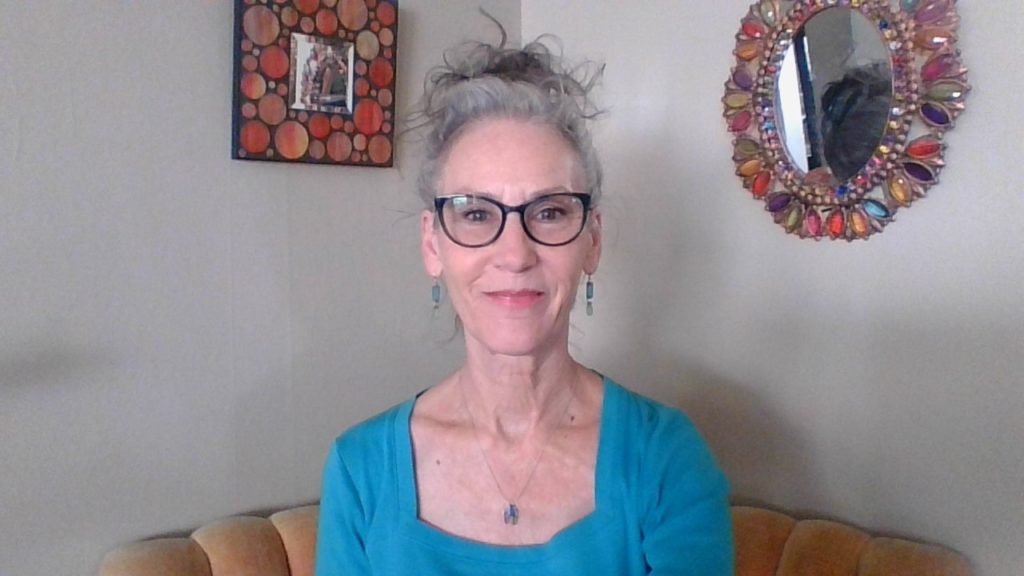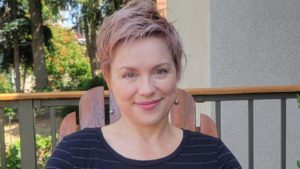Jenn Gibbs’s “The WhiskeyJack” and Interview By Pamela Balluck
I met Jenn Gibbs when we were graduate students at the University of Utah, each transplants from elsewhere, each emphasizing creative writing. Gibbs earned an MFA in Creative Writing from Bowling Green State University and a PhD in English and American Literature from the U of Utah, where she writes, edits, and manages information design projects for an educational technology nonprofit. Her fiction and nonfiction have appeared in The Chattahoochee Review, The Gettysburg Review, Literature and Racial Ambiguity, Brevity’s Nonfiction Blog and other publications. The fiction we discuss in today’s interview, “The Whiskeyjack,” won the Utah Original Writing Competition in the short story category before blessedly coming to the Ocean State Review. Readers, if you have not already consumed Gibbs’s story in OSR’s Tenth Anniversary Issue, you can find it here: “The Whiskeyjack”
Pamela Balluck: Thank you, Jenn Gibbs, for continuing our conversation about your award-winning short fiction, “The Whiskeyjack,” in which a woman who is a twin, a mother, and a wife, is hit with enormous and mind-boggling loss all at once. Despite what she’s going through, I enjoy very much being in her boggled mind, as she is trying to think and act her way through a bizarre situation in which she is realizing how she is an outsider though closely co-existing with others. What sparked this compelling story for you?
Jenn Gibbs: Thank you, Pam. As a writer yourself, you probably know what I mean when I say you have to grow into some of your own ideas. This story started maybe twenty years ago with some anecdotes my biologist cousin shared about her field research, including observing Canada Jays in the north woods. Though I’d spent a fair amount of time in the wilderness, I didn’t think I’d ever have the patience to do what she did. From that space between us came the ghost of a character on a field research team who didn’t belong—how I’d be if I tried stepping into my cousin’s shoes—but I couldn’t see more than a vague silhouette. Why was she there? Who was she? When I tried to write about her, shapeless, lackluster pages would happen and I’d move on to another project. Then years later, after I’d become a parent and had a million other perspective shifts, the first line of this story appeared and, through it, so did Lindsay.
PB: I love that the same questions you needed to answer as a creative writer are echoed by Lindsay’s own questions in the story: Why was her sister where she was? And, who is Lindsay independent of her twin? Is it even possible for her to be independent of Emma? In other ways, your story further explores such relationships by including details about how siblings of another species, the Canada Jay, compete for resources. How did facts about the birds contribute to your ideas about Lindsay and Emma? What role did research play in the evolution of this story?
JG: Research played a big role. The first task was shopping for the right bird to put at the center of the plot. I wanted to set the story in the Rockies, but I was more familiar with northeastern forests, so I needed to consult maps of bird territories before committing. I was happy to see that the Canada Jay—also known by many more names—could work geographically. The more I learned about these cool little creatures, the more thematic connections appeared. For instance, I had already written my way into Lindsay and Emma’s territorial issues as sisters when I read about Canada Jay sibling disputes in a science journal. It was one of those moments in the creative process where you feel stories have lives of their own and you’re just there in a tree with binoculars, waiting, watching, noting.
PB: Lindsay’s realization of just how many names refer to the same bird is handled by you in such a way that readers not in-the-ornithological-know can be surprised and learn with her. We’re in her head as she learns how to experience the camp she lands in. What other kinds of information did you need to gather in writing this story?
JG: When I realized the direction Lindsay’s story was going in, I reached out to my cousin for what researchers call a semi-structured interview. While she shared her take on some of the logistics of fieldwork, that conversation was more about getting a sense for how it feels to be in the skin of a person doing this work. That helped me lay deeper tracks for my characters, but I still needed to get beyond what other people said and wrote by getting out into it. This was one reason I wanted to set the story in the west, where I could access the setting more easily.
After I committed to my setting, I was offered a spot in an artists’ colony at the University of Utah’s Taft-Nicholson Center in Montana. In addition to giving me time away from the preoccupations of life with a family and full-time job that isn’t writing fiction, the Center gave me access to the astounding beauty of Centennial Valley and the wildlife refuge there. It also had on staff a naturalist who was very generous with her expertise. (Thank you, Erin!) Getting out and trying to view that space through my characters’ senses was important to me. While the research station in my story is a fictional one, I could imagine my characters in it all that much more clearly thanks to these strokes of grace from other people.
PB: Even though Lindsay is in a daze, getting to the camp and being in the camp are so vivid for me as a reader.
JG: I’m so glad!
PB: When I solicited you about considering “The Whiskeyjack” for publication in the Ocean State Review, the story had already won the Utah Original Writing prize when it was longer than it is now. How did you feel at the prospect of revising down the word count?
JG: Formal constraints can be our friend! While I did my level best to make the version I submitted to the competition as strong as I could, and clearly I had some success, editing the story to better fit OSR’s needs was a good opportunity to winch it tighter. On top of that, notes from skilled and attentive readers—Katharine Coles and Jacqueline Osherow at the University of Utah, the competition judge Jon Billman, and OSR’s editors—gave me much-needed perspective and renewed energy to advance the work through its different stages.
As you were one of these caring readers from OSR, along with Elizabeth Foulke and Charles Kell, it may sound like I’m buttering you up, but I want to make a point about the interdependence of writers, editors, and readers. I used to think I was supposed to make a thing in isolation and put it out in the world to succeed or fail. While yes, much of the labor of writing is solitary, and yes, performance is a type of test, focusing on that dynamic made the editorial process feel to me like a system of validation and reprimand. And while I like validation as much as the next writer, I’m now more interested in viewing creative work as part of a conversation with people I enjoy and respect. The whole process of creation, including sprucing up a piece like “The Whiskeyjack” for publication, is made richer that way.
PB: And it’s a rich experience for a reader. Every time I go back to the story, it shows me something new. Thank you, Jenn, for discussing your story with me. We at OSR love “The Whiskeyjack” and invite our readers to love it, too.
JG: Thank you, Pam.
Jenn Gibbs is a writer, editor, and communication Swiss Army knife specializing in prose forms and the creative process. She makes art, a living, and a life in Salt Lake City about which she occasionally writes in her not-very-blog, Invisible Sun.
Pamela Balluck’s stories have appeared in publications that include Western Humanities Review, PANK, Green Mountains Review, and Southeast Review. Her creative nonfiction has been listed as “Notable” in Best American Essays. She teaches writing at the University of Utah and is a Contributing Editor for the Ocean State Review.


